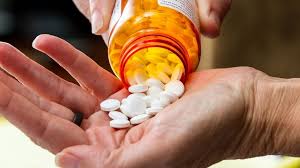 Opioid use disorder (OID) defined by 11 diagnostic criteria, occurring over a 12 month period.
Opioid use disorder (OID) defined by 11 diagnostic criteria, occurring over a 12 month period.
The National Survey on Drug Use and Health (NSDUH) reported in 2019 an estimated 1.6 million people in the US had OUD and in 2022, this estimate jump to 6.1 million people.
HHS estimates there now 9.4 million people with OUD in the US.
The great increase is related to the number of people who have been prescribed opioids for pain and take them as prescribed.
Data now suggest 62% of the estimated 4.8 million people with OUD involve prescribed opioids that don’t misuse their medications.
Only about 11% of people in the US diagnosed with opioid juice disorder, receive substitution therapy.
Symptoms include taking more of the opioid agent than intended, failed attempts to stop the opioid, excessive time spent obtaining the opioid, cravings for opioids, failure to fulfill obligations, repetitive interpersonal conflicts, giving up and quitting things for the opioids, using opioids despite knowing this substance is causing significant emotional or physical consequences, tolerance, and withdrawal.
The relative severity of the opioid use disorder relates to mild, moderate, and severe process is defined by the relative number of symptoms that an individual exhibits.
Opioid prescriptions are a major risk factor for the development of substance use disorders, with almost 30% of patients prescribed opioids for chronic pain misusing them and up to 12% developing opioid-use disorders.
The US represents about 4% of the world‘s population but prescribes 80% of painkillers and accounts for 27% of deaths due to drug overdose.
Opioid use disorder is present in more than 25% of patients receiving opioids for chronic pain.
1/3 of people with opioid use disorder have been involved with the criminal justice system in the previous year.
Hallmarks of opioid use disorder include: emotional volatility, taking more medication than prescribed, using opioids for reasons other than pain, frequent loss of medications/prescriptions or early refills.
Only 11% of patients with an opioid use disorder are prescribed medications for the disorder.
The majority of abused prescription opioids are prescribed to friends and acquaintances of those who abuse them.
The prevalence of opioid use disorder among pregnant persons has increased steadily since 2000.
The opioid use disorder affects more than eight per thousand deliveries.
The opioid use disorder in pregnancy affects Medicaid patients at approximately two times the rate of the general population.
The opioid epidemic has been associated with an increase in bacterial and fungal infections as well as new HIV and hepatitis C virus outbreaks.
Opioid use disorder (OUD) treatment combines medications and behavioral therapies.
FDA-approved medications include methadone an opioid agonist, that reduces cravings, buprenorphine a partial agonist, often combined with naloxone), and naltrexone an antagonist, blocks opioid effects post-detox.
Methadone requires specialized clinics, while buprenorphine can be prescribed in primary care.
Behavioral approaches like cognitive-behavioral therapy, contingency management, and family counseling helps address issues.
Despite evidence supporting these treatments, only 25.1% of U.S. adults needing care received medications in 2022.
An alternative to gradually tapering off opioids is transitioning to buprenorphine, a medication commonly used for the treatment of opioid use disorder.
Buprenorphine is a higher affinity partial agonist at mu-opioid receptors that has a ceiling effect on sedation and respiratory depression without clinically relevant ceiling on analgesia.
Methadone and Buprenorphine are the primary opioid agonists for the treatment of opioid use disorder.
Methadone and Buprenorphine promote retention in treatment programs, reduced use of illicit drugs, and consistently decrease mortality.
Receipt of methadone is associated with the lower risk of treatment discontinuation compared with buprenorphine/naloxone.
Injectable and implantable buprenorphine can expand access in opioid use disorder treatment and reduce opioid mortality and morbidity.
In patients on long-term opioid therapy the risk of overdose increases dramatically when benzodiazepines, muscle relaxers, gabapentin, or the CNS depressants are also prescribed.
The concomitant use of opioids and benzodiazepines increases the risk of overdose death by nearly 4 times.
Coprescribing naloxone in patients who have a history of overdose with substance use disorder prescribed in patients receiving a daily morphine equivalent dose of more than 50 mg is associated with 63% reduction in overdose emergency department visits at one year.
Observational studies show that a single opioid prescription in a emergency department, after surgery, or at a dentist’s office, 1-6% end up using opioids for at least 12 months of being diagnosed with opioid use disorder.
